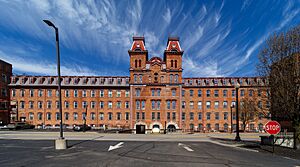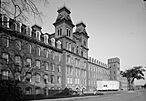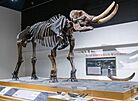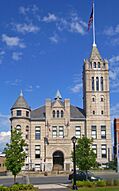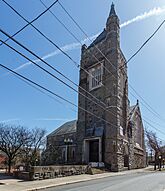Cohoes, New York facts for kids
Quick facts for kids
Cohoes, New York
|
||
|---|---|---|
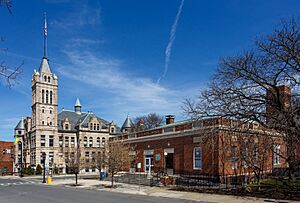
City Hall and Post Office
|
||
|
||
| Etymology: Dutch adaptation of Mohawk "Ga-ha-oose" for "place of the falling canoe" | ||
| Nickname(s):
Spindle City
|
||
| Motto(s):
A Community That Cares
|
||
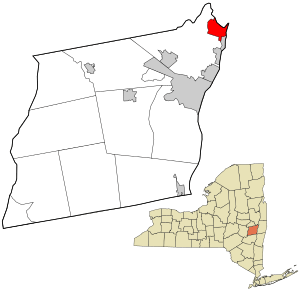
Location in Albany County and the state of New York.
|
||
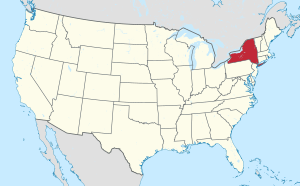
Location of New York in the United States
|
||
| Country | United States | |
| State | New York | |
| County | Albany | |
| Incorporation as village | 1848 | |
| Incorporation as city | 1869 | |
| Government | ||
| • Type | City Hall | |
| Area | ||
| • Total | 4.24 sq mi (10.97 km2) | |
| • Land | 3.77 sq mi (9.77 km2) | |
| • Water | 0.46 sq mi (1.20 km2) | |
| Elevation | 80 ft (20 m) | |
| Highest elevation
(Elizabeth Court)
|
310 ft (90 m) | |
| Lowest elevation
(Hudson River)
|
10 ft (3 m) | |
| Population
(2020)
|
||
| • Total | 18,147 | |
| • Density | 4,809.70/sq mi (1,857.18/km2) | |
| Demonym(s) | Cohoesier | |
| Time zone | UTC-5 (Eastern (EST)) | |
| • Summer (DST) | UTC-4 (EDT) | |
| ZIP Code |
12047
|
|
| Area code(s) | 518 | |
| FIPS code | 36-16749 | |
| GNIS feature ID | 0947009 | |
| Wikimedia Commons | Cohoes, New York | |
| Website | [1] | |
Cohoes (pronounced kə-HOHZ) is a city in the northeast part of Albany County, New York. It's often called the "Spindle City." This nickname comes from its history of making textiles, especially cotton, in the 1800s.
In 2020, about 18,174 people lived in Cohoes. The name "Cohoes" likely comes from a Mohawk word, Ga-ha-oose. This word means "Place of the Falling Canoe," referring to the Cohoes Falls. Some historians also think it might come from an Algonquian word for 'pine tree'.
Contents
History of Cohoes
Early Settlement and Dutch Influence
Long ago, much of Cohoes was part of a large Dutch settlement called Manor of Rensselaerswyck. This area was like a huge farm owned by a Dutch merchant named Killiaen Van Rensselaer. In 1632, he claimed a big triangle of land where the Mohawk and Hudson rivers meet. This land became the center of what is now Cohoes.
The Cohoes Falls were a famous landmark even then. In 1642, a Dutch pastor named Johannes Megapolensis described the falls. Later, in 1656, Adriaen van der Donck also wrote about them. An interesting story from the 1600s tells of a whale that swam up the Hudson River. It got stuck on an island below the Cohoes Falls. The smell from the whale was so strong it could be noticed for miles! This island was then called Whale Island.
During the French and Indian Wars in the mid-1700s, Van Schaick Island became important. It was part of a military road from Albany that helped soldiers cross the Mohawk River. This island was used for many military camps during these wars and the American Revolutionary War. The Van Schaick Mansion was built there in the 1730s. It served as a military headquarters during the Revolution.
Growing as a Community
After the Revolutionary War, Cohoes slowly began to grow. In 1795, the first bridge over the Mohawk River was built in Cohoes. It was a long toll bridge, meaning you had to pay to cross. This bridge helped connect Cohoes to bigger towns like Lansingburg and Albany.
A huge step for Cohoes was the building of the Erie and Champlain canals. Work started in 1817, and the Cohoes section was done by 1823. These canals made it much easier to move goods by water. Cohoes was even called "Juncta" because the two canals met there. This helped the city's trade a lot. In 1831, Cohoes finally got its own post office.
The Industrial Age in Cohoes
In 1811, the Cohoes Manufacturing Company started a factory to make screws. This was the first big industry in Cohoes to use the strong power of the Mohawk River and Cohoes Falls.
In 1831, a new Cohoes Company built a dam on the Mohawk River. This dam helped control the water flow for factories. Ironworks became a major industry in Cohoes. The Daniel Simmons' Simmons Axe Company was very famous.
Textile Industry Boom
In the 1820s, the first cotton mill in Albany County was built in Cohoes. Soon, Cohoes became a big center for making textiles. The Harmony Manufacturing Company, later known as Harmony Mills, was founded in 1836. Cohoes became a "mill town," where many people worked in the factories.
By the 1870s, the mills were making a lot of money. The Erie Canal helped them ship cotton textiles to New York City, England, and Europe. Mill #3, which was over 1,000 feet long, was one of the longest continuous textile mills in the country.
In 1848, Cohoes became a village. Then, in 1869, it officially became a city.
The Cohoes Mastodon Discovery
In 1866, something amazing was found during the building of Harmony Mill #3. Workers dug up the bones of a mastodon! This huge, elephant-like animal lived in this area a very long time ago.
The Cohoes Mastodon skeleton was shown for many years at the New York State Museum in Albany, New York. Now, a replica of the mastodon, complete with fur, is on display at the Cohoes Public Library.
By 1872, the Harmony Mills were the biggest cotton mill complex in the world. Many immigrants came to Cohoes to work in these mills. This included French Canadians from Quebec and Irish people. The Harmony Mills Historic District is now a protected historic site.
Around 1900, a daredevil named Bobby Leach practiced going over the Cohoes Falls in a barrel. He later did the same stunt at Niagara Falls. People in Cohoes watched him from a hotel called The Cataract House.
Cohoes in the 21st Century
From 2005 to 2013, the Harmony Mills buildings were updated. They were turned into fancy apartments, which helped bring new life to the city center.
On November 30, 2017, a large fire damaged many buildings in Cohoes. Strong winds caused the fire to spread quickly. Twenty-one buildings were badly damaged or destroyed.
Since 2020, Cohoes has been working on a big project to improve the city. They have spent millions of dollars to fix sidewalks and plant trees. They also redesigned city parks and added charging stations for electric cars. A new waterfront park was also created.
In 2017, West End Park was updated to honor veterans. In 2020, Canal Square Park in downtown Cohoes was redesigned. It now hosts farmer's markets, outdoor concerts, and other events.
Geography of Cohoes
Cohoes covers about 4.2 square miles (10.9 square kilometers). Most of this is land, but about 0.5 square miles (1.2 square kilometers) is water.
The city is located where the Mohawk River meets the Hudson River. The Mohawk River splits into several channels and islands here. Cohoes is famous for the beautiful Cohoes Falls. The city also includes Van Schaick Island and Simmons Island.
Cohoes is surrounded by other towns. To its northwest, west, and south is the town of Colonie. To the south of Van Schaick Island is the town and village of Green Island. Across the Mohawk River to the north is Saratoga County and the town of Waterford. A bridge connects Cohoes to Waterford. To the east, across the Hudson River, is the city of Troy.
Population of Cohoes
| Historical population | |||
|---|---|---|---|
| Census | Pop. | %± | |
| 1850 | 4,229 | — | |
| 1860 | 8,800 | 108.1% | |
| 1870 | 15,357 | 74.5% | |
| 1880 | 19,416 | 26.4% | |
| 1890 | 22,509 | 15.9% | |
| 1900 | 23,910 | 6.2% | |
| 1910 | 24,709 | 3.3% | |
| 1920 | 22,987 | −7.0% | |
| 1930 | 23,226 | 1.0% | |
| 1940 | 21,955 | −5.5% | |
| 1950 | 21,272 | −3.1% | |
| 1960 | 20,129 | −5.4% | |
| 1970 | 18,653 | −7.3% | |
| 1980 | 18,144 | −2.7% | |
| 1990 | 16,825 | −7.3% | |
| 2000 | 15,521 | −7.8% | |
| 2010 | 16,168 | 4.2% | |
| 2020 | 18,147 | 12.2% | |
| U.S. Decennial Census | |||
In 2010, there were 16,168 people living in Cohoes. This was a bit more than in 2000. The city had about 7,001 households.
About 84% of the people were White, and about 12% were African American. Other groups made up the rest of the population. About 3% of the people were Hispanic or Latino.
The average age in Cohoes was 38 years old. About 22% of the people were under 18 years old.
Arts and Culture in Cohoes
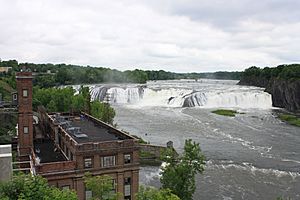
Cohoes has several important historic places. These sites are listed on the U.S. National Register of Historic Places. They help tell the story of the city's past.
Historic Sites to See
- Cohoes Music Hall
- Delaware and Hudson Railroad Freight House
- William J. Dickey House
- Downtown Cohoes Historic District
- Enlarged Erie Canal Historic District (Discontiguous)
- Fonda House
- Godfrey Farmhouse
- Harmony Mill No. 3
- Harmony Mills Historic District
- J. Leonard Lackman House
- Lock 18 of Enlarged Erie Canal
- Matton Shipyard
- Olmstead Street Historic District
- Silliman Memorial Presbyterian Church
- Van Schaick House
Transportation in Cohoes
Several main roads run through Cohoes. New York State Route 787 ends in Cohoes. New York State Route 32 goes north and south through the city. New York State Route 470 crosses east and west, connecting Cohoes to the northern parts of Troy over the Hudson River.
Years ago, trains used to stop in Cohoes. The Delaware and Hudson Railroad ran trains like the Laurentian (from New York to Montreal) until the mid-1950s.
Notable People from Cohoes
Many interesting people have connections to Cohoes:
- Charles H. Adams was mayor of Cohoes and later a US Congressman.
- Ron Canestrari served as mayor and then as an Assemblyman, becoming a Majority Leader.
- George Davis was a famous baseball player and manager. He is in the National Baseball Hall of Fame.
- James Lafferty was a politician in Wisconsin.
- Zach Remillard is a current Major League Baseball player for the Chicago White Sox.
- Harold E. Rosecrans was a Brigadier General in the Marine Corps during World War II.
- Chester Arthur, who later became a U.S. President, lived in Cohoes in 1852. He was a school principal here. His family members were also important community leaders in Cohoes.
See also
 In Spanish: Cohoes (Nueva York) para niños
In Spanish: Cohoes (Nueva York) para niños



